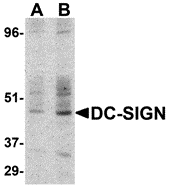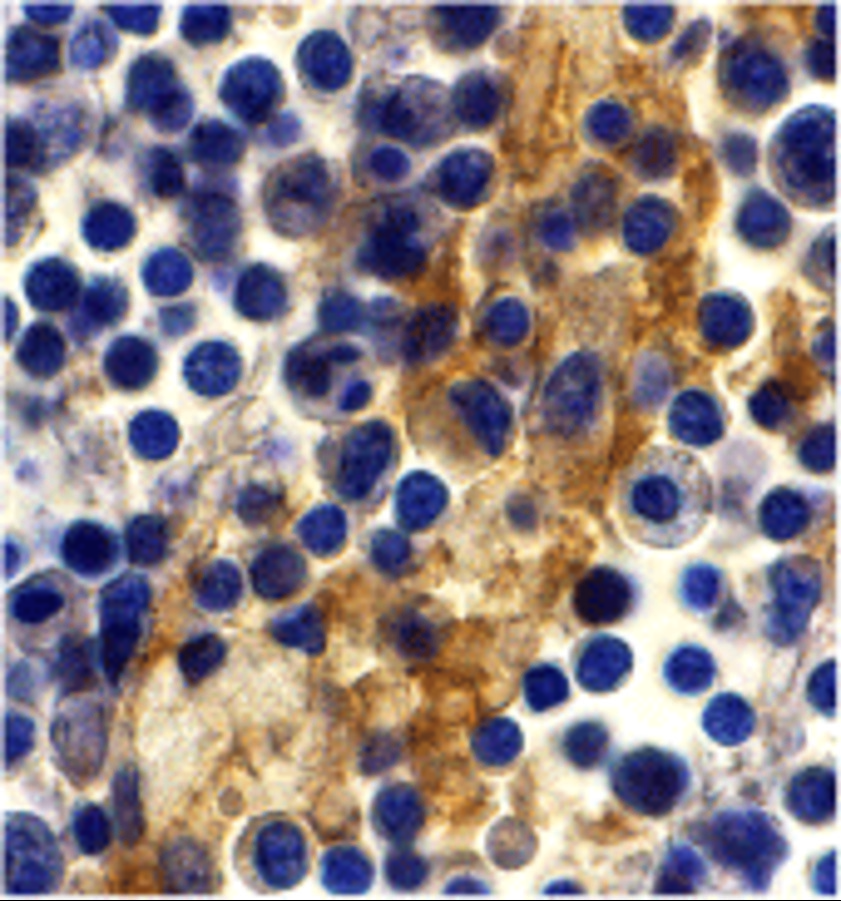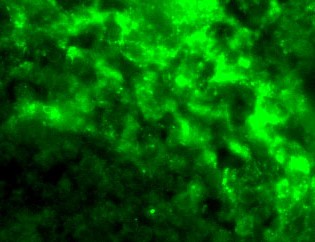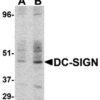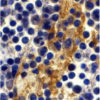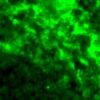Anti-DC-SIGN (CT) Antibody (18710)
$469.00
SKU: 18710
Categories: Antibody Products, Infectious Disease Antibodies, Products
Overview
Product Name Anti-DC-SIGN (CT) Antibody (18710)
Description Anti-DC-SIGN (CT) Rabbit Polyclonal Antibody
Target DC-SIGN (CT)
Species Reactivity Human
Applications ELISA,WB,IHC-P,IF
Host Rabbit
Clonality Polyclonal
Immunogen Peptide corresponding to aa 384-404 of human DC-SIGN.
Properties
Form Liquid
Concentration Lot Specific
Formulation PBS, pH 7.4.
Buffer Formulation Phosphate Buffered Saline
Buffer pH pH 7.4
Format Purified
Purification Purified by peptide immuno-affinity chromatography
Specificity Information
Specificity This antibody recognizes an epitope at the C-terminus of human DC-SIGN, a dendritic cell receptor that can capture and transport HIV from mucosal areas to remote lymph nodes where HIV is then transferred to CD4 T lymphocytes. Multiple strains of HIV-1, HIV-2, and SIV bind to dendritic cells via DC-SIGN. DC-SIGN is expressed in mucosal tissues, placenta, small intestine, and rectum.
Target Name CD209 antigen
Target ID DC-SIGN (CT)
Uniprot ID Q9NNX6
Alternative Names C-type lectin domain family 4 member L, Dendritic cell-specific ICAM-3-grabbing non-integrin 1, DC-SIGN, DC-SIGN1, CD antigen CD209
Gene Name CD209
Accession Number NP_001138365.1
Sequence Location [Isoform 1]: Cell membrane, Single-pass type II membrane protein, Single-pass type II membrane protein, Single-pass type II membrane protein, Single-pass type II membrane protein, Single-pass type II membrane protein
Biological Function Pathogen-rPubMed:11859097}.; On DCs it is a high affinity receptor for ICAM2 and ICAM3 by binding to mannose-like carbohydrates. May act as a DC rolling receptor that mediates transendothelial migration of DC presursors from blood to tissues by binding endothelial ICAM2. Seems to regulate DC-induced T-cell proliferation by binding to ICAM3 on T-cells in the immunological synapse formed between DC and T-cells. {PubMed:10721995, PubMed:11017109, PubMed:12574325}.; (Microbial infection) Acts as an attachment receptor for HIV-1 and HIV-2. {PubMed:11799126, PubMed:12502850, PubMed:1518869}.; (Microbial infection) Acts as an attachment receptor for Ebolavirus. {PubMed:12502850, PubMed:12504546}.; (Microbial infection) Acts as an attachment receptor for Cytomegalovirus. {PubMed:12433371, PubMed:22496863}.; (Microbial infection) Acts as an attachment receptor for HCV. {PubMed:15371595, PubMed:16816373}.; (Microbial infection) Acts as an attachment receptor for Dengue virus. {PubMed:12682107}.; (Microbial infection) Acts as an attachment receptor for Measles virus. {PubMed:16537615}.; (Microbial infection) Acts as an attachment receptor for Herpes simplex virus 1. {PubMed:18796707}.; (Microbial infection) Acts as an attachment receptor for Influenzavirus A. {PubMed:21191006}.; (Microbial infection) Acts as an attachment receptor for SARS-CoV. {PubMed:15140961}.; (Microbial infection) Acts as an attachment receptor for Japanese encephalitis virus. {PubMed:24623090}.; (Microbial infection) Acts as an attachment receptor for Lassa virus (PubMed:23966408). Acts as an attachment receptor for Marburg virusn. {PubMed:15479853}.; (Microbial infection) Acts as an attachment receptor for Respiratory syncytial virus. {PubMed:22090124}.; (Microbial infection) Acts as an attachment receptor for Rift valley fever virus and uukuniemi virus. {PubMed:21767814}.; (Microbial infection) Acts as an attachment receptor for West-nile virus. {PubMed:16415006}.; (Microbial infection) Probably rPubMed:16092920, PubMed:16379498, PubMed:21203928}.
Research Areas Infectious Disease
Application Images




Description Western blot detection of DC-SIGN in human small intestine at (A) 1 and (B) 2 ug/ml.

Description Immunohistochemistry of DC-SIGN in human lymph node tissue with DC-SIGN antibody at 10 ug/mL.

Description Immunofluorescence of DC-SIGN in Human Lymph Node tissue with DC-SIGN antibody at 20 ug/mL.
Handling
Storage This antibody is stable for at least one (1) year at -20°C. Avoid multiple freeze- thaw cycles.
Dilution Instructions Dilute in PBS or medium that is identical to that used in the assay system.
Application Instructions Immunoblotting: use at 1-2 ug/mL. In immunoblots, a band of 44 kD is detected.
Positive control: Human placenta tissue lysate.
Positive control: Human placenta tissue lysate.
References & Data Sheet
Data Sheet  Download PDF Data Sheet
Download PDF Data Sheet
 Download PDF Data Sheet
Download PDF Data Sheet

